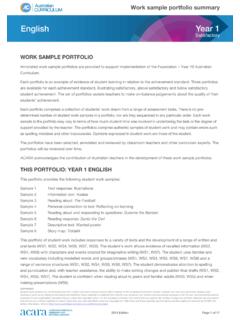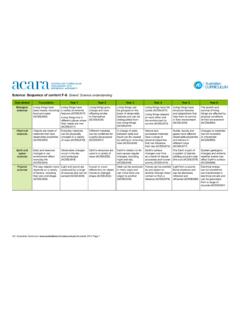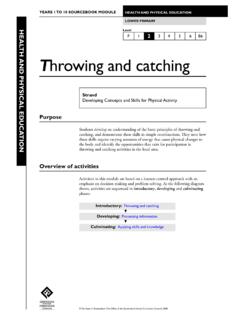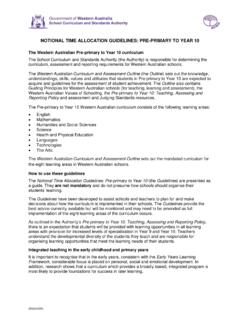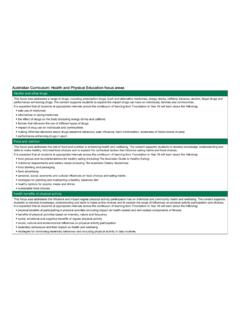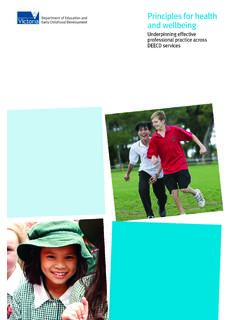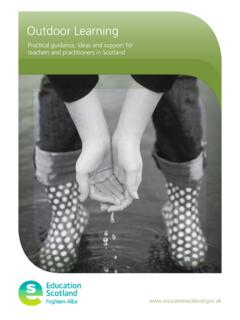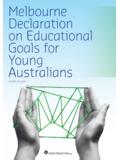Transcription of Information for parents. The Australian Curriculum ...
1 Years 3 4 Years 5 6 Years 7 8 Years 9 10 Years 1 2 FoundationYears 1 2 Years 3 4 Years 5 6 Years 7 8 Years 9 10 Information for parentsTHE Australian Curriculum FOUNDATION YEARTHE Australian CURRICULUMThe Australian Curriculum is designed to develop: successful learners confident and creative individuals active and informed young people who are ready to take their place in society. It sets the goal for what all students should learn as they progress through their school life wherever they live in Australia and whatever school they Australian Curriculum with its eight learning areas provides a modern Curriculum for every student in Australia. Included in the content of learning areas are seven general capabilities intended to help prepare young Australians to learn, live and work in the 21st century. There are three cross- Curriculum priorities that are also a focus across the learning areas.
2 The Australian Curriculum is flexible so that teachers can plan the learning for all their students, also taking into account their local school community. For more Information , see our fact sheet: The Australian Curriculum an overview for FIRST YEAR OF SCHOOLIn their first year of school, students learn through teaching interactions with others, experimentation, practice and play in the classroom and school community. Priority is given to literacy and numeracy development as these are the foundations upon which further learning is built. Opportunities to develop literacy and numeracy are found in all subjects but particularly in English and Mathematics. Learning in a classroom and belonging to a school community are key to the first year at state and territory has a different name for the first formal year of schooling such as Reception , Kindergarten Pre-Primary or Prep.
3 Foundation Year Learning Areas1 FoundationEnglishMathsScienceHealth & PEThe ArtsHumanitiesLanguagesTechnologiesSchoo l choiceYears 3 4 Years 5 6 Years 7 8 Years 9 10 Years 1 2 FoundationNumber, order, sequence, pattern, positionConnects events with days of the a text that includes a pictureEnglishIn the first year of school, students view, listen to and enjoy texts that entertain and inform, such as picture books or, rhymes. They begin to learn to read and create texts. Typically, students will: communicate with others in familiar situations read stories with one or more sentences, pictures and familiar vocabulary recognise rhyming words, syllables and sounds recognise letters and the most common sounds the letters make listen to, read and view picture books, stories, poetry, Information books, films and performances write some words recognise some words and develop skills in sounding out words create their own texts such as giving Information orally or in writing.
4 Presenting a narrative, which may include the first year of school, students develop a sense of number, order, sequence, pattern and position in relation to familiar , students will: connect numbers, their names and quantities up to 20 count numbers in sequences up to 20, continue patterns and compare lengths of objects use materials to model problems, sort objects and discuss answers group and sort shapes and objects connect events with days of the week develop an understanding of location words, such as above, outside, 3 4 Years 5 6 Years 7 8 Years 9 10 Years 1 2 FoundationHealth and physical EducationStudents learn through active play, and practise fundamental movement skills. They learn about how their body is growing and changing, about their strengths, how to be healthy, safe and active, and about respectful relationships with students will: use their strengths to help others name trusted people in their community, who can help them stay safe and healthy describe emotions of people who are happy, sad, excited, tired, angry, scared or confused group foods into eat always and eat sometimes move in different speeds and directions, be aware of others and follow rules play games from different cultures move in time with a partner when music is and Social SciencesBy experimenting, practising and playing in familiar situations, students use their natural curiosity to make sense of their world, and to develop history and geography knowledge and skills about people and , students will.
5 Explore their personal world, including personal and family histories investigate places they and their families live in and belong to find out about other places through stories told in books, or by family members and other people, and how people feel about places explore why places are special and how students and other people can care for exploration and observation, students learn how science works. They explore their world to find answers to , students will: explore the needs of living things investigate the properties of everyday materials explore changes in our world, for example, the weather explore how things a place that is special to 3 4 Years 5 6 Years 7 8 Years 9 10 Years 1 2 FoundationThe ArtsStudents share their experiences and understanding of themselves through exploring the arts and , students will.
6 In Dance, watch others dance and respect those around them when they are dancing in Drama, use role play to act out familiar events or stories in Media Arts, use a camera to record images for others to view in Music, explore sounds when listening, singing and making music in Visual Arts, respond to and create a variety of artworks by drawing and exploration, design and problem-solving, students learn how technologies , students will:in Design and Technologies design and create solutions to challenges through guided play and by safely using materials and equipmentin Digital Technologies work safely online, represent data as pictures, symbols and diagrams, and sequence steps to solve simple may have an opportunity to learn a language other than English. Typically, when learning the language, students will: imitate sounds, rhythms and patterns of a language use simple words and phrases, and non-verbal communication strategies in familiar situations read and write simple words with visual support.
7 44To learn more about the Australian Curriculum , visit the Parents section of the Australian Curriculum website. For more Information about your child, talk to your a tablet to sequence stepsCreates artworks by drawing and painting





